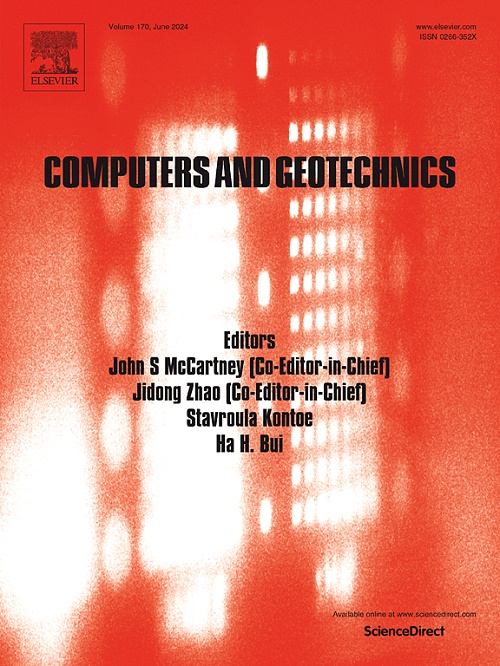Comparative Analysis of microcracking behaviors and associated acoustic emission characteristics in sandstone subjected to compression-induced and direct tensile stresses
IF 5.3
1区 工程技术
Q1 COMPUTER SCIENCE, INTERDISCIPLINARY APPLICATIONS
引用次数: 0
Abstract
Rocks often undergo both direct tensile actions and indirect tensile actions induced by compression due to tectonic movements and human engineering activities, leading to the gradual accumulation of microcracks accompanied by acoustic emission (AE) events. However, to date, the differences in the microcracking behavior and associated AE of rocks under these two tensile conditions, as well as the underlying micromechanical mechanisms, have not been thoroughly understood. Here, we conducted a direct tensile test on a dog-bone-shaped sandstone sample and a Brazilian splitting test (representing compression-induced tension) on a disc-shaped sample. Corresponding nonlinear particle-based discrete element models were developed to simulate the tensile stress-displacement responses and macroscopic failure modes of the two sandstone samples. Results showed that sandstone under direct tension exhibits significantly lower strength than under compression-induced tension. In the disc-shaped model, microcracks appeared progressively at dispersed times, accompanied by high-frequency AE signals, mainly concentrated near the longitudinal symmetric axis, adjacent to the loading point. Conversely, microcracks in the dog-bone-shaped model appeared abruptly and were concentrated within a narrow range near the horizontal symmetric axis, with microcracks and energy release uniformly distributed, and fractures tending to be perpendicular to the loading direction. Compared to compression-induced tension, the dog-bone-shaped model exhibited smaller AE counts, energy release, and AE signal frequency, but a larger b-value, more than three times as high. Micromechanical analysis revealed that these differences are primarily due to significant variations in tensile/compressive contact force chains and strain energy distributions in particle assemblies under direct and compression-induced tension.
压缩应力与直接拉应力作用下砂岩微裂纹行为及声发射特征对比分析
由于构造运动和人类工程活动,岩石经常受到直接的拉伸作用和由压缩引起的间接拉伸作用,导致微裂纹逐渐积聚并伴有声发射(AE)事件。然而,迄今为止,岩石在这两种拉伸条件下的微裂纹行为和相关声发射的差异,以及潜在的微力学机制尚未完全了解。在这里,我们对狗骨状砂岩样品进行了直接拉伸测试,并对圆盘状样品进行了巴西劈裂测试(代表压缩诱发张力)。建立了相应的基于颗粒的非线性离散元模型,模拟了两种砂岩试样的拉应力-位移响应和宏观破坏模式。结果表明:砂岩在直接拉伸作用下的强度明显低于压缩拉伸作用下的强度;在盘状模型中,微裂纹在分散时间逐渐出现,伴随着高频声发射信号,主要集中在纵向对称轴附近,靠近加载点。相反,狗骨型模型微裂纹出现较突然,且在水平对称轴附近集中在较窄的范围内,微裂纹和能量释放分布均匀,裂缝趋向于垂直于加载方向。与压缩张力模型相比,狗骨模型的声发射计数、能量释放和声发射信号频率较小,但b值较大,为压缩张力模型的3倍以上。微观力学分析表明,这些差异主要是由于颗粒组件在直接张力和压缩张力下的拉伸/压缩接触力链和应变能分布的显著差异。
本文章由计算机程序翻译,如有差异,请以英文原文为准。
求助全文
约1分钟内获得全文
求助全文
来源期刊

Computers and Geotechnics
地学-地球科学综合
CiteScore
9.10
自引率
15.10%
发文量
438
审稿时长
45 days
期刊介绍:
The use of computers is firmly established in geotechnical engineering and continues to grow rapidly in both engineering practice and academe. The development of advanced numerical techniques and constitutive modeling, in conjunction with rapid developments in computer hardware, enables problems to be tackled that were unthinkable even a few years ago. Computers and Geotechnics provides an up-to-date reference for engineers and researchers engaged in computer aided analysis and research in geotechnical engineering. The journal is intended for an expeditious dissemination of advanced computer applications across a broad range of geotechnical topics. Contributions on advances in numerical algorithms, computer implementation of new constitutive models and probabilistic methods are especially encouraged.
 求助内容:
求助内容: 应助结果提醒方式:
应助结果提醒方式:


